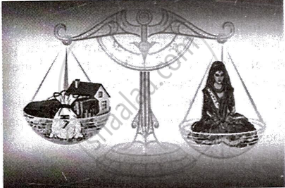Advertisements
Advertisements
Question
Read the passage given below and answer the questions that follow:
| Alka belonged to a traditional joint family. Her grandfather was the Head of the family and took all important decisions for all the members. As decided by her grandfather, Alka and her sisters were trained in the household work from an early age by the women in the family. They were made to develop their cooking skills. On the contrary, her brothers were encouraged to pursue academics and take up professions of their choice. |
- Name the ideology practised in Alka's family. [1]
- Briefly explain the impact of the ideology identified in subpart (i), on the inheritance rights of women and their status at workplace. [4]
- Identify and briefly explain the gender issue depicted in the image shown below. [2]

Solution
- Alka's family follows traditional patriarchal values. Patriarchy is a social structure where men hold power and authority, while women face systematic oppression and marginalisation.
-
- Traditional patriarchy has a huge impact on women's inheritance rights and professional prestige. In patriarchal societies, male heirs frequently have greater inheritance rights than female heirs due to men's primary authority and decision-making ability. Traditionally, property, money, and wealth are passed down to sons, maintaining economic gaps and reinforcing male privileges within families.
- Traditionally, women are expected to perform household chores and caregiving obligations, as demonstrated by Alka and her sisters, who were instructed from a young age. The gender division of labour restricts women's prospects for education, skill development, and employment outside the house. As a result, women may encounter challenges to economic independence.
- Traditional patriarchy fosters gender inequality by limiting women's inheritance rights, reinforcing gender roles and responsibilities, and hindering their advancement in the job.
-
- The graphic depicts a gender issue related to dowry. Dowry is the practice of transferring significant gifts, money, or property from the bride's family to the groom's family after marriage, which is common in many cultures worldwide. Dowry remains illegal in many nations, resulting in financial burdens, exploitation, and gender-based violence against women.
- Dowry issues can lead to harassment, death, and abuse for brides and their families. This social tradition reinforces gender inequality, economic inequity, and commodification of marriage. Legal and societal reforms are needed to eliminate this detrimental practice and protect women's rights.
APPEARS IN
RELATED QUESTIONS
Answer briefly the following questions :
What is meant by domestic violence?
Define gender bias. Examine its consequences for both, men and women.
Answer the following question briefly :
Differentiate between sex and gender.
Discuss any three gender-related issues. Briefly mention the bills and amendments to deal with them.
Answer the following question briefly:
Mention any two social reforms that led to the change in the status of women in Pre- British and British India.
What does gender bias imply? Mention any four consequences of gender bias.
Answer briefly the following question :
What is Fetishism?
______ was the practice of killing the unborn female child.
A historical Hindu practice which was initially voluntary for a widow led to the degradation in the status of women in India. Define this system which is now banned.
Patriarchal ideology undervalues attributes seen as “feminine” or pertaining to women and privileges traits that are “masculine” or relating to men.
Reflect on the above statement and with the help of any four arguments, outline the impact of such an ideology on different genders.
